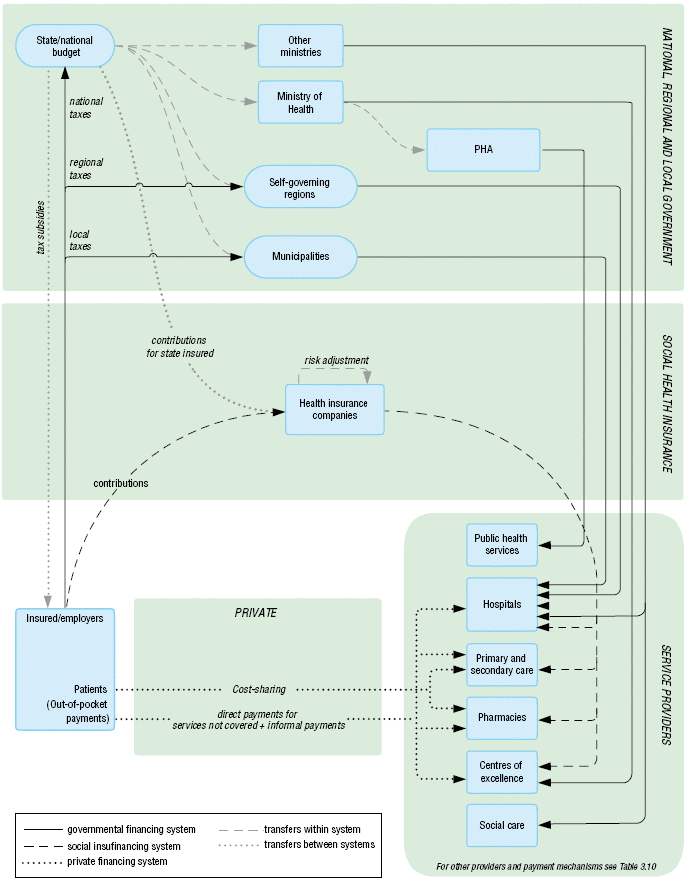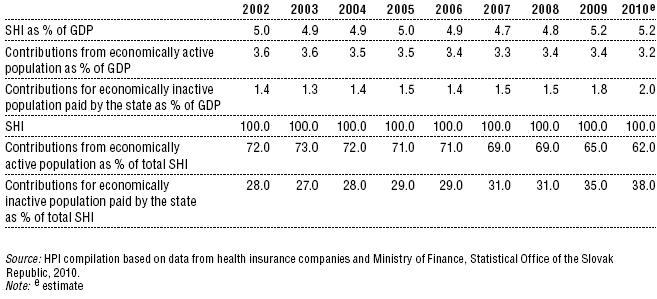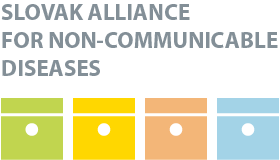—
HPI Network > HPI - Health Policy Institute > Health System in Slovakia > 3. Financing > 3.2 Sources of revenue and financial flows
3.2 Sources of revenue and financial flows
Thursday, 05. May 2011, 0:47 — HPI
| << PREVIOUS
3.1 Health expenditure |
Introduction – Organization – Financing – Resources – Provision – Reforms – Assessment – Conclusions – Appendices |
NEXT >>
3.3 Overview of the statutory financing system |
Following the establishment of Slovakia in 1993, the Bismarck system of SHI was reintroduced by establishing the National Insurance Fund, which was made responsible for financing health, sickness and pension insurance. In 1994, the Act on Health Insurance was adopted, which allowed the establishment of multiple health insurance funds and, at the same time, defined the SHI financing mechanism as a combination of contributions from the economically active population, employers, and contributions from the state budget on behalf of the economically inactive population. In the meantime, a chronic deficit in the system became a problem. Soft budget restrictions, insufficient regulation of the health sector as well as ineffective policies played a key role in growth of the deficit. Therefore, the health reform in 2002–2006 was primarily aimed at tightening budgetary restrictions, increasing the effectiveness of utilization of resources as well as identifying internal reserves of the system. The reform included a transformation of health insurance funds, which were public institutions, into joint stock companies, now called health insurance companies.
Since 1993, health system financing has gone through multiple changes (see also Chapter 6). Substantial changes which have had an impact on the volume of resources in health care include linking the state contributions on behalf of the economically inactive population to economic growth, and increasing these contributions from 4% to 4.9% of the average salary in 2009.
In 2010, the Slovak health system provides universal coverage for a broad range of benefits. The main sources of revenue in the health system are contributions paid to the health insurance companies under the SHI system (see Fig. 3.5). These include contributions by (1) employees and employers, (2) self-employed people, (3) voluntarily unemployed, and (4) “state-insured”. The latter term is used for the significant group of mostly economically inactive people for whom the state pays contributions (approximately two-thirds of the population and one-third of total resources from contributions).
Contributions are collected by health insurance companies. The resources of health insurance companies are risk adjusted for two demographic predictors, age and gender of insured, and, since 2010, for the characteristic “state-insured”. Between 2008 and 2011, health insurers were allowed to use their profit only for health care purchasing. This legislative measure was heavily criticized by private insurers and led to international arbitrations against Slovakia. The EC sent a formal letter of notice to Slovakia in late 2009 expressing concerns that the law breaches the EC Treaty. In January 2011 the Constitutional court ruled that the profit restriction was unconstitutional and nullified it.
Payments to providers are subject to a contract that determines the amount of payments, the type and quality of services, and the payment system. Furthermore, the health insurance companies fund the HCSA in proportion to their revenue.
Apart from the state-insured, the central government budget finances the activities of several ministries, most notably the Ministry of Health. The Ministry of Health, for example, funds the PHA, the state-run Slovak Health University and covers small investment costs in some state hospitals. Self-governing regions and municipalities are responsible for investment costs in their hospitals and outpatient centres.
Lastly, out-of-pocket payments include direct payments, cost-sharing and informal payments. Because of the very broad definition of the SHI benefit package, VHI plays only a very marginal role.
Table 3.4 provides a breakdown of the resources in the Slovak health care system. The composition of SHI resources has changed significantly since 2002. In 2002, 72% of resources came from contributions of the working population and 28% of the resources were contributions by the state on behalf of the stateinsured from general tax revenue. In 2010, the share of these state contributions to total revenue will reach 38%. In 2010, the payment of the state will be 2.0% of GDP, while in 2002 this figure was only 1.4%.
These changes in structure are the consequences of the Insurance Act reform in 2004, which introduced the following measures.
- Change of state contributions on behalf of the state-insured into a percentage of the average monthly wage. In the past, the state contribution was the result of a political decision, the amount depending on the state budget.
- The introduction of a precise definition of a state-insured person. Contributions paid by the National Office of Labour for unemployed insured as well as payments by the Social Insurance Company for insured on sick leave were abolished. Both groups became state-insured.
- Setting the minimum and maximum assessment base as a function of the real economy. Previously, both limits had been set by a fixed price, which resulted in valorization problems (also see section 3.3.2 Collection).
- An annual settlement of the SHI contribution was introduced, in order to consolidate the financial flow as well as to prevent insured individuals avoiding their obligatory contributions by manipulating their income level. At the same time, it protects people who previously had paid high contributions (above the assessment base) or who have double incomes (for example, a job and their own business).
Fig. 3.5: Financial flows in the health care system, 2010

Table 3.4: Resources of the SHI system, as % of GDP and breakdown of economically active and non-active population

News
The amendment of the Decree on emergency medical service
Health insurance companies returned over 400 thousand €
The HCSA received 1,647 complaints last year
A half million people will earn more
Most of public limited companies ended in the black
Debt of hospitals on premiums has grown to nearly € 105 MM
Slovak health care may miss € 250 million next year
Profits of HIC amounted to € 69 mil. last year
Owners of Dôvera paid out money but did not paid taxes
Like us on Facebook!
Our analyses
- 10 Years of Health Care Reform
- New University Hospital in Bratislava
- Understanding informal patient payments in Kosovo’s healthcare system
- Analysis of waiting times 2013
- Health Policy Basic Frameworks 2014-2016
- Analysis of informal payments in the health sector in Slovakia
- Serbia: Brief health system review
developed by enscope, s.r.o.
